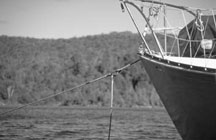The wind had shifted overnight. A sea was starting to run into the anchorage from the exposed direction, so we decided to leave. We finished the breakfast dishes and pulled in the “off-duty hook.” Karen motored up to the windward hook. I snubbed the rode as she went over it. It broke out; I pulled it in and stowed both anchors and rodes. I was still humming cheerfully to myself when I closed the starboard cockpit locker over the storm anchor and sat down to finish my tea.
A lot had changed since we started hooking with “little” Mystic. In the beginning I didn’t hum much, and my tea would have gotten cold before I got the anchors stowed.
It took me a while to get interested in anchoring. The first serious anchors in my life weighed 22 tons. A single link of the all-chain rode was more than a strapping young sailor could lift. I honestly never doubted that such gear would “take the ground” and hold a 22,000-ton cruiser securely.
I still was not worrying much about anchors years later when I raced my Flying Scot. Class rules said we had to carry an anchor, so I did – the smallest one I could get away with. There was no mention of chain in the rules, so I didn’t carry chain. It would have added weight, and I never once considered the possibility that I would actually anchor that little daysailer anyway. She was drysailed from her lift and only on race days.
Then we bought Mystic, maybe 10,000 pounds in cruising trim. Suddenly I had a serious interest in anchoring. We had enough anchoring adventures during the first season to learn the questions. It took several more seasons of experimenting to learn some of the answers.
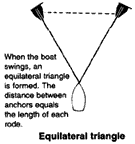
Things change
In among islands and against the shore where most anchoring is done, the wind direction may vary during the course of an evening. By sundown, when we most often anchor, the breeze is frequently off the land – not necessarily the prevailing wind direction of a few hours earlier nor the direction of the predicted shift. Anchors are normally set to the existing wind at the moment of anchoring. It’s the easiest thing to do. At least the boat will tend properly to her anchor for a while, but often the wind will be from another direction by morning.
If there is a tidal current involved, the odds are it will have changed direction by morning. Some sailors rely on their anchor to reset itself when it is pulled out of the bottom and dragged in a new direction. Most of the time an anchor will do that, but not always. Slash, debris, rocks, weeds, and even heavy clay and mud can prevent an anchor from resetting. We figure our odds of a reset are about as good as our odds of getting a set in the first place: good, but not good enough.
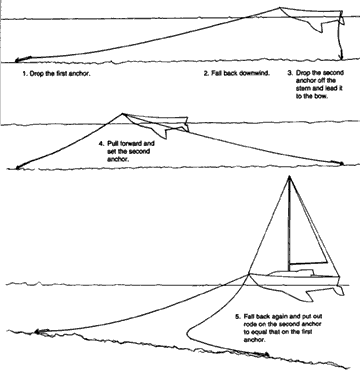
In those early days, we were never blown ashore nor out to sea because of an anchor that failed to reset. We learned that cold fronts and thunderstorms always have a wind shift associated with them. We had our anchor drag because of these shifts, but we were always awake and able to respond quickly. We reasoned that Neptune was trying to tell us something, and if we didn’t heed the message delivered in daylight, we were sure to get one in the wee small hours. We started experimenting with alternatives, looking for a better way.
Use two anchors
The anchoring method that follows is a variation of Bahamian mooring, which may be defined simply as using two anchors off the bow. The beauty of this method is that as the boat swings with wind and tide, she hangs from one anchor, then both, and then finally the other anchor in tending through a 180-degree swing. Any wind direction can be accommodated. As with so many aspects of sailing, it is the details that determine the success or failure of this method.
The simple case
Most of the time it is this simple: Drop the first anchor, fall back downwind about seven times the depth, and set it. Drop the second anchor off the stern. Pull in about half of the first rode and set the second anchor by hand pulling from the bow. Put equal lengths of rode out for both anchors. Use a rode length roughly equal to the distance between the two anchors in the bottom.
We normally anchor in 14 to 16 feet, and let out 100 feet of rode for each anchor. That gives us roughly a 7:1 scope, which works well for the kind of anchors we use. We want our anchors about 100 feet apart on the bottom. By dropping off the stern and setting from the bow, we give the second anchor some distance to set and some added scope. After the first anchor sets and the engine stops pulling astern, the boat will spring forward on the elasticity of the rode. To get it to the bottom before the boat moves forward, drop the second anchor just as the prop stops. Then, to keep the rodes out of the prop, it is better to pull the boat forward without the engine. If the engine must be used to move forward, control both lines to keep them out of the prop. Note: both anchors are deployed without using the dinghy. Nothing in this method requires rowing an anchor
out to deploy it.
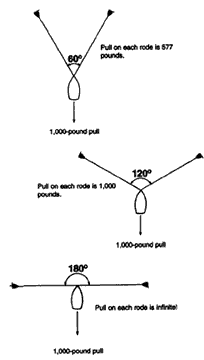
When simple’s not enough
In more challenging situations, it is good to understand how your boat can move when Bahamian moored; it is also important to understand the direction and magnitude of the loads on the anchor system.
You can see in the illustration that in a single anchor mooring the boat is free to move within a circle with a radius roughly equal to the length of rode that is out (ignoring scope and three-dimensional considerations for simplicity).
With a single anchor, it is necessary to make sure that, if your boat swings toward shore, you will have enough depth. This requires anchoring farther off to allow for the swing. Even so, there is always some guesswork in making this allowance, and sometimes it would be nice to go closer to shore.
Closer to the shore
Note in the illustration that with a Bahamian moor, the boat is only free to move within the common zone of the intersection of the two circles. With this arrangement, when you drop the first anchor up against the windward shore, you are as close to shore as you are going to get. The anchor to leeward will not allow you to get any closer. Knowing this allows you the option of going in closer to shore when there is an advantage to doing so. Considering the example above of anchoring in 14 to 16 feet of water and letting out 100 feet of rode, if you choose, you could anchor in 7 feet of water and let out 50 feet of rode (vessel draft and tide permitting).
Anchoring in closer quarters
Because she is constrained within the common zone of the intersection of the two circles, your boat will not swing over as much area, so you can anchor in closer quarters. Using the example above, instead of the area within a 200-foot diameter circle, your boat will be restricted to a bloated diamond shape that is 100 feet across the short dimension and 173 feet across the long dimension. This is substantially less than half the area of the alternative circle. By knowing that the longest dimension of the diamond is perpendicular to the two anchors, you can lay them to best advantage in close quarters.
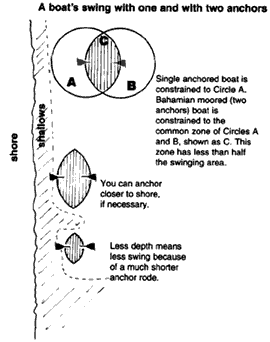
Restrict your swing more
There are two more ways you can reduce the area of your swing. Remember you have the option of going in closer with a Bahamian moor. If you were to anchor in 7 feet and let out 50 feet of rode, you would swing inside of a diamond only 50 by 87 feet. Have a care for the tide and the regularity of the bottom, if you cut it that close.
You can also anchor, as in the first example, initially letting out 100 feet of rode so the anchors are about 100 feet apart in the bottom, and then you can shorten both rodes to something less than 100 feet. (See illustration.) This works well enough but has drawbacks. If you shorten both rodes to 75 feet, you will only have 5:1 scope. If you shorten the rodes to 58 feet you will be at 4:1. Depending on the kind of anchors you have, this may or may not be beyond their limit. In our experience with our Fortress and Viking (both aluminum fluke-style) anchors, 7:1 is conservative, 5:1 is workable, and 4:1 might not be such a good idea. Always go with “conservative” when you can. There are some obvious variations of this method that are not recommended. One obvious way to restrict the swing of your boat is to put in two anchors widely spaced and then pull in all the slack so the boat is fastened to a straight line made up of the two rodes. Don’t do that. There will be no problem as long as the boat is pulling along the line between the two anchors, directly on one anchor or the other. However, if the boat were to pull in a direction perpendicular to the line between the two anchors, it would have infinite mechanical advantage until the lines stretched, the anchors dragged, or something broke.
To give you a sense of how this works, look at the illustration. With the anchors 100 feet apart, 100 feet of rode let out to each anchor, and the boat pulling perpendicular to the axis through the anchors, there is an equilateral triangle formed. Each leg is 100 feet. With the boat pulling 1,000 pounds force on the combined system, the pull on each anchor rode is 577 pounds, or slightly more than half. If you haul in enough of each rode to make the angle between the two rodes go from 60 degrees – as in the first case – to 120 degrees, the pull on each rode will be 1,000 pounds when the boat is pulling 1,000 pounds on the combined system. This may seem like cheating, but it gets worse. If you could make the angle between rodes 150 degrees, the pull on each rode will be 1,932 pounds. And as we said, if you could pull all the rode in to make the angle between the rodes 180 degrees, the pull on each rode would be infinite. That won’t last long in reality, because something will give, and the angle will increase. We recommend that you use the equilateral triangle layout where possible and always limit the angle between rodes to less than 120 degrees. Within these limits, the pull on any rode is never larger than the total pull from the boat.
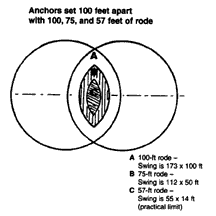
Another variation we do not recommend is to let out more rode than the distance between the anchors, for example, letting out 200 feet of rode when the anchors are set 100 feet apart. This will increase your scope, but it will also allow the rode from the “loaded” anchor to lay over, and possibly foul, the unloaded anchor. By limiting the individual rode lengths to the distance between the anchors, the rodes never quite lay over and foul the anchors. Even with the equilateral triangle arrangement we prefer, a strong bottom current might be able to wash an anchor’s own rode over it and so foul it. In areas with very strong currents, pulling in some rode might be helpful to prevent this.
A few small details
We usually anchor in the lee of the land. We put in our smaller anchor first. The larger anchor is set to seaward. It has more chain with it, and is more likely to set when pulled by hand. A blow from the direction of shore puts less of a load on the anchors because the shore blunts the effect of the wind, and there are no waves. Our smaller anchor handles that direction. A blow from seaward puts more load on the system, having more wind and waves, so our larger (storm) anchor is set in that direction. Set the bigger anchor against the bigger load.
If the bottom has a very steep slope, you may be confronted with setting the second anchor in fairly deep water, perhaps 25 feet. If that happens, don’t worry so much about the anchor scope, which would theoretically be 4:1. The sloping bottom will work in favor of the situation, making the effective pull on the anchor quite parallel to the bottom, which is all that a long scope accomplishes.
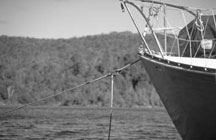
Ways to rig the anchors
We have not tried this technique with a wide range of anchor types and rodes. We use a Viking and a Fortress, both aluminum fluke anchors similar to a Danforth in shape. The smaller Viking is on six feet of chain, and the Fortress FX 16 (sized to be a storm anchor) is on 15 feet of chain. We have not tried to do any of this with an all-chain rode, but we can’t think of why it would not work.
We first tried using a 200-foot line with thimbles at both ends, tying it off in the middle at the boat. That works fairly well, but translates into a lot of line to move, pile, and stow. We have found a much handier alternative. Omega Pacific makes a hardened steel carabiner that has the proper working strength for our anchoring system. We use 1/2-inch nylon double braid and 5/16-inch proof coil chain. We use carabiners to connect the anchors to the chains and the chains to the rodes. We use two 100-foot rodes with thimbles at each end and a third line (which need not be very long for anchoring) to connect the two rodes to each other and to cleat off on deck.
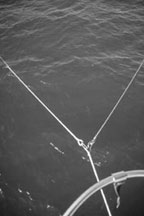
This rigging allows the boat to swing on the anchors without the rodes twisting up. (See photo.) What little twist there is, we can untwist when we bring the junction of the three lines aboard. We originally got these carabiners to use with our sea anchor. We didn’t want to spend too much time on the foredeck with shackles, marlinespikes, safety wire, and wire cutters while the boat was pitching in a large sea. We thought it better to have rigging that could be worked with one hand. We rig our sea anchor to the anchor rodes and can let out 600 feet of line because the “short line” described earlier is really a tied-off 400-footer, with the remaining 380 feet of it packed in a cotton laundry bag stored below. The carabiners are the key to making up this rig in a hurry in heavy weather conditions. They also allow the two anchors to be rigged and put over or retrieved and stowed more easily. All parts of the system can be broken down quickly without tools because of the carabiners.
The corrosion resistance of the carabiners is an issue. They are certainly fine for use in fresh water. We have used them on Lake Superior without a problem for several years. Salt water is another matter. We have learned that these fittings are used for towing underwater research equipment in saltwater service but are not used, to our knowledge, for ocean anchoring.
We contacted the manufacturer, Omega Pacific, and asked them if they had any plans to make a more corrosion-resistant carabiner for marine saltwater service. Bill Griggers, marketing manager, explained that the existing carabiners are made from hardened steel with a high-quality zinc chromate/gold plating. They have stainless steel rivets and springs and are considered adequate for freshwater service. He noted that Omega Pacific is developing a line of all-stainless steel carabiners for marine use. We asked Bill to tell us when this product is on the market. There are galvanized anchor shackles available that are strong enough, and less costly, but they are not as handy.
There you have it. Two hooks put in properly will contribute more to a good night’s sleep than a hot cocoa, a roomy bunk, and a thick mattress. Happy hooking.
Article from Good Old Boat magazine, March/April 1999.

